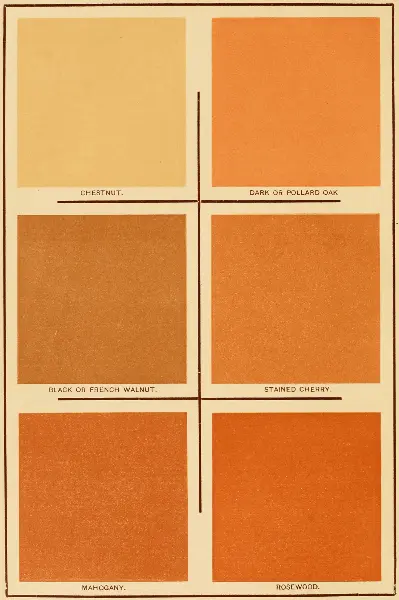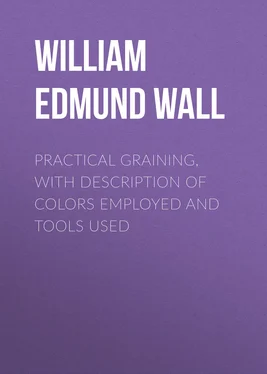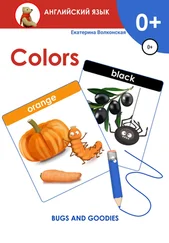William Wall - Practical Graining, with Description of Colors Employed and Tools Used
Здесь есть возможность читать онлайн «William Wall - Practical Graining, with Description of Colors Employed and Tools Used» — ознакомительный отрывок электронной книги совершенно бесплатно, а после прочтения отрывка купить полную версию. В некоторых случаях можно слушать аудио, скачать через торрент в формате fb2 и присутствует краткое содержание. Жанр: Хобби и ремесла, foreign_home, на английском языке. Описание произведения, (предисловие) а так же отзывы посетителей доступны на портале библиотеки ЛибКат.
- Название:Practical Graining, with Description of Colors Employed and Tools Used
- Автор:
- Жанр:
- Год:неизвестен
- ISBN:нет данных
- Рейтинг книги:5 / 5. Голосов: 1
-
Избранное:Добавить в избранное
- Отзывы:
-
Ваша оценка:
- 100
- 1
- 2
- 3
- 4
- 5
Practical Graining, with Description of Colors Employed and Tools Used: краткое содержание, описание и аннотация
Предлагаем к чтению аннотацию, описание, краткое содержание или предисловие (зависит от того, что написал сам автор книги «Practical Graining, with Description of Colors Employed and Tools Used»). Если вы не нашли необходимую информацию о книге — напишите в комментариях, мы постараемся отыскать её.
Practical Graining, with Description of Colors Employed and Tools Used — читать онлайн ознакомительный отрывок
Ниже представлен текст книги, разбитый по страницам. Система сохранения места последней прочитанной страницы, позволяет с удобством читать онлайн бесплатно книгу «Practical Graining, with Description of Colors Employed and Tools Used», без необходимости каждый раз заново искать на чём Вы остановились. Поставьте закладку, и сможете в любой момент перейти на страницу, на которой закончили чтение.
Интервал:
Закладка:
William E. Wall
Practical Graining, with Description of Colors Employed and Tools Used
MAPLE OR SATIN WOOD. LIGHT ASH.
LIGHT OAK. HUNGARIAN ASH.
CHAPTER I.
GROUND-WORKS FOR GRAINING
THE following remarks, while not claiming to be anything new or startling, will perhaps be of interest to those who seek to improve themselves in the modern style of imitating the grain of wood. The ideas set forth in these pages are founded on the observation and every-day experience of a grainer to the trade who does not claim to be the best in the world, but who offers his suggestions for the good of the craft.
Graining is often overlooked in the rage for stained white wood or olive greens in interior work, but it will always find favor with those who have experienced its wearing qualities as compared with plain painted work; for should the varnish be of good quality and not crack, the work, if properly done, will stand for years and will not fade in the manner that paint does, and where the work is properly done on new wood it cannot be chipped off unless the wood is taken off with it. It can be scoured off, but will not come off otherwise. Where graining is done over old paint or over work that has been previously grained the case is different, as, if knocked or bruised, it will chip off to the coat beneath, and where the work has formerly been white the effect is very bad and is hard to remedy; but if care is taken when grounding the work, it may to a great extent be prevented.
In preparing old work for graining one of the first things requisite is to have the surface made as smooth as possible; this may be done with sand-paper or—what is better—lump pumice stone.
In case the graining is done over old paint that has cracked the best thing to do is to remove the old varnish or paint by the application of a strong solution of washing soda or a weak solution of potash. Some painters use spirits of ammonia or burn off with a burning-lamp. After thoroughly softening or removing the old paint or varnish with either soda or potash, the work should be washed off with a weak solution of vinegar (about a pint of vinegar to a pailful of water), in order to remove all traces of the alkali and prevent its future action on the paint. Some painters think that this is too much trouble and assert that they cannot get paid for doing work in this way, but in the end it will prove to be the best way, as it will greatly add to the appearance and durability of any job so to prepare it. In any case the work should be thoroughly sand-papered and made as smooth as possible before receiving the first coat; this, of course, is for old work. The ground-color should be thinned with about half spirits of turpentine and half oil, with the addition of sufficient drier for old work, and oil, with an extra quantity of drier, for first coat on new work, using some spirits for the second and third coats.
The writer has found by experience that on the cheapest jobs (of two-coat work) where the wood is sappy and the work has been rendered rough by the painter using a large quantity of drier in his priming coat, a much better surface is made to grain over by this method. It will not spot or look cloudy when rubbed in to grain, as two-coat work often does on new wood.
A little "elbow-grease" and sand-paper between coats make a vast difference in the looks of a job when finished, and the ground-work should always be lightly sand-papered before it is rubbed in by the grainer.

CHESTNUT. DARK OR POLLARD OAK.
BLACK OR FRENCH WALNUT. STAINED CHERRY.
MAHOGANY. ROSEWOOD.
In mixing the ground-color for graining never use dry colors where it can be avoided, as the work will be more or less gritty, and there is really no saving in their use. A pound of color ground in oil will go much further than one of dry color, is more easily applied and is much better to grain over. Of course much depends on the purity of the colors employed, and the painter will find that the best colors are none too good for his use, as they go further and work better than do the cheaper grades. It is a good plan always to strain the color before thinning, whether the colors used be dry or ground.
The foregoing may seem superfluous to the good workman, as he himself has probably found out more than this; but it may put some beginner on the right track, and none of us are expert enough to miss learning a point if we can.
The ground-work for oak is made by adding yellow ochre to lead till the color is deep enough. In matching the real wood a little raw umber will help to bring it to the desired color, but is better without the umber for light work.
In matching very light oak chrome yellow may be substituted for ochre. For dark oak use the same colors as for light and add Venetian red and burnt umber; the same color will do for pollard oak. For green oak ( á la furniture ) do the same as for ordinary work, and when grained shade it over with a thin wash of chrome green or add a little black to the ground color. For ash use the same color as for light oak, but do not get it quite so yellow; a little raw umber will counteract this. A little chrome yellow may be added for Hungarian ash. For chestnut use a similar color to that for ash, but deeper and with a little red. For maple the ground-work should be very light. To an ordinary pot two-thirds full of lead well broken up add about a teaspoonful of chrome yellow and about half that amount of burnt sienna; some grainers prefer a very little Venetian red instead of the burnt sienna. In matching the wood get the ground-work as near the lightest color on the wood as possible, and you cannot go astray. For satin-wood the ground-work is similar to maple, but deeper in color. For burl ash use the same color as for ash, or slightly deeper.
The ground-work for cherry is probably mixed differently by every painter—at least, that is my experience—and it is hard work to make any workman believe that his is not the right way. In different parts of the country the popular idea of what "cherry color" is, varies greatly. In the majority of cases what has been called "the color of the fruit" is wanted, so we must make the ground-work to suit the demand. Cherry in its natural color is but little darker than ash, and the ground-work may be made in the same way or by adding raw sienna to the lead instead of yellow ochre and umber. The cherry that grainers have to match is often finished by furniture-makers, and is as dark as mahogany; in such cases the ground-work must be made with yellow ochre for the basis of the color and darkened by Venetian red. It will want little if any lead for the darker kinds of stained cherry, but will stand some for the lighter shades. In priming new work add considerable lead for first coat, as it gives more body. Three thin coats are none too many for new work, and they should be applied without leaving brush-marks. There is nothing more aggravating to the grainer than to find that a job is full of streaks of thick paint, as it is almost impossible to do a good job on such a ground-work.
The foregoing remarks apply to priming coats on new wood for graining any kind of wood.
The ground-work for walnut is made by taking yellow ochre for the base of the color and adding a small quantity of Venetian red and a little burnt umber; for very light work a little lead may be added. The same ground will do for French walnut. For mahogany the ground-work is made of yellow ochre, Venetian red and red lead. For rosewood chrome yellow, red lead and a small quantity of Venetian red. The foregoing are about all the woods that a grainer in New England is called upon to imitate; and if I mistake not, it is so elsewhere. Of course all painters or grainers may not agree with me in using the colors named for preparing the ground-work, but good work can be done on such grounds. One thing I wish to say is, Never use Indian red in a ground-color, as it is not transparent and makes the work look muddy. In grounding work for cherry or walnut, where the old paint is not removed, it is well to add some red lead to the color, which should be frequently stirred, or the red lead will deposit on the bottom of the pot.
Читать дальшеИнтервал:
Закладка:
Похожие книги на «Practical Graining, with Description of Colors Employed and Tools Used»
Представляем Вашему вниманию похожие книги на «Practical Graining, with Description of Colors Employed and Tools Used» списком для выбора. Мы отобрали схожую по названию и смыслу литературу в надежде предоставить читателям больше вариантов отыскать новые, интересные, ещё непрочитанные произведения.
Обсуждение, отзывы о книге «Practical Graining, with Description of Colors Employed and Tools Used» и просто собственные мнения читателей. Оставьте ваши комментарии, напишите, что Вы думаете о произведении, его смысле или главных героях. Укажите что конкретно понравилось, а что нет, и почему Вы так считаете.












